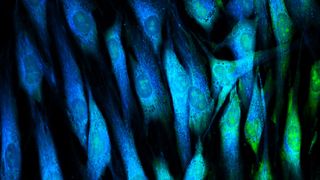Skin cells made 30 years younger with new 'rejuvenation' technique
Never before have cells been de-aged by so many years and still retained their specific type and function.

Researchers in the U.K. have developed a way to reverse the aging process in skin cells, turning back the biological clock by about 30 years.
De-aging cells has become increasingly common in the last decade, with researchers reprogramming multiple mouse, rat and human cell types (opens in new tab). But never before have cells been de-aged by so many years and still retained their specific type and function.
The method, developed by Diljeet Gill, a postdoctoral candidate at the Babraham Institute in Cambridge, and his colleagues, was published April 8 in the journal eLife (opens in new tab), and has been dubbed "maturation phase transient reprogramming."
The researchers applied this technique to fibroblasts (a common type of skin cell) from three middle-aged donors — who averaged at about 50 years old — then compared them to younger cells from donors aged 20 to 22. The researchers found that the middle-aged cells were similar to the younger cells, both chemically and genetically. When explored further, the team even noticed that the technique had affected genes related to age-related diseases, like Alzheimer's disease and cataracts.
In addition, Gill and his colleagues looked at the behavior of the fibroblasts to determine if they could also act like younger skin cells. When they wounded a layer of the cells, they found that the rejuvenated cells quickly moved to fill the gap — the same way that younger cells behave when healing wounds.
This study is not the first to de-age skin cells. That title goes to Nobel prize winner Shinya Yamanaka, who genetically reprogrammed mouse skin cells and turned them into so-called induced pluripotent stem cells, or iPSCs, back in 2006. These iPSCs resemble cells in early development, and have the potential to form any cell type in the body.
Related: What are stem cells?
The new research is based in part on Yamanaka's method, but there are key differences. Yamanaka's method takes around 50 days and completely reprograms cells to the biological age of an embryo. Gill's method takes just 13 days and only partially reprograms cells so that they still retain their identity (in this case, the identity of skin cells.).
While turning mature cells into stem cells is great for research, the complete reprogramming process is not ideal for therapeutics. Completely reprogrammed cells lose their identities and specialized cell functions. And when implanted into the body, these fully reprogrammed cells can become cancerous.
In contrast, partially reprogrammed cells, like the skin cells in Gill's research, become biologically younger and retain specialized cell functions, though they could still potentially pose a risk of cancer. "Our results represent a big step forward in our understanding of cell reprogramming," Gill said in a statement (opens in new tab). "We have proved that cells can be rejuvenated without losing their function and that rejuvenation looks to restore some function to old cells."
While their work is very promising, Gill and his colleagues acknowledge that their paper is a proof-of-concept study. The authors said that they’re not sure how fibroblasts from younger or older individuals would react to the new reprogramming method, or if cells from people of very different ages would always de-age by 30 years.
Another issue is that Gill's technique is still based off of Yamanaka's method. It's still not known how the reprogrammed cells might behave inside a living organism or what risks they pose.
Ben Van Handel, a stem cell biologist and co-founder of the skin care company Heraux and the biopharmaceutical company CarthroniX, said that the technique "will never be used in a clinical setting as it is currently a type of gene therapy that would be impossible to use in humans." There's still a lot of concern about these cells becoming cancerous and controlling how far back in age the rejuvenation process goes.
But this doesn't take away from the study's impact. "The way in which it was done will not be applicable in the real world, [but] the research is valuable," Handel told Live Science. "We may discover practical ways of doing it by studying the process...and that is important!"
Study lead author Dr. Wolf Reik, institute director of the biotechnology company Altos Labs and former principal investigator at the Babraham Institute, said the study's long-term implications are very exciting. "Eventually, we may be able to identify genes that rejuvenate without reprogramming, and specifically target those to reduce the effects of aging," he said in the statement.
Originally published on Live Science
Live Science newsletter
Stay up to date on the latest science news by signing up for our Essentials newsletter.
Siddhi Camila Lama is an independent science, health and gastronomy writer who is also the managing editor of HairScience.org. She's written for Orb Media, Atlas Obscura, BrainFacts, Medium's science and tech publication, One Zero, and more. Siddhi is a certified nutritionist with a bachelor's in Human Development, a master's in Organ, Tissue, and Cellular Transplantation, and a Ph.D. in Bioengineering.
Most Popular

By Harry Baker

By Ben Turner

By Jamie Carter